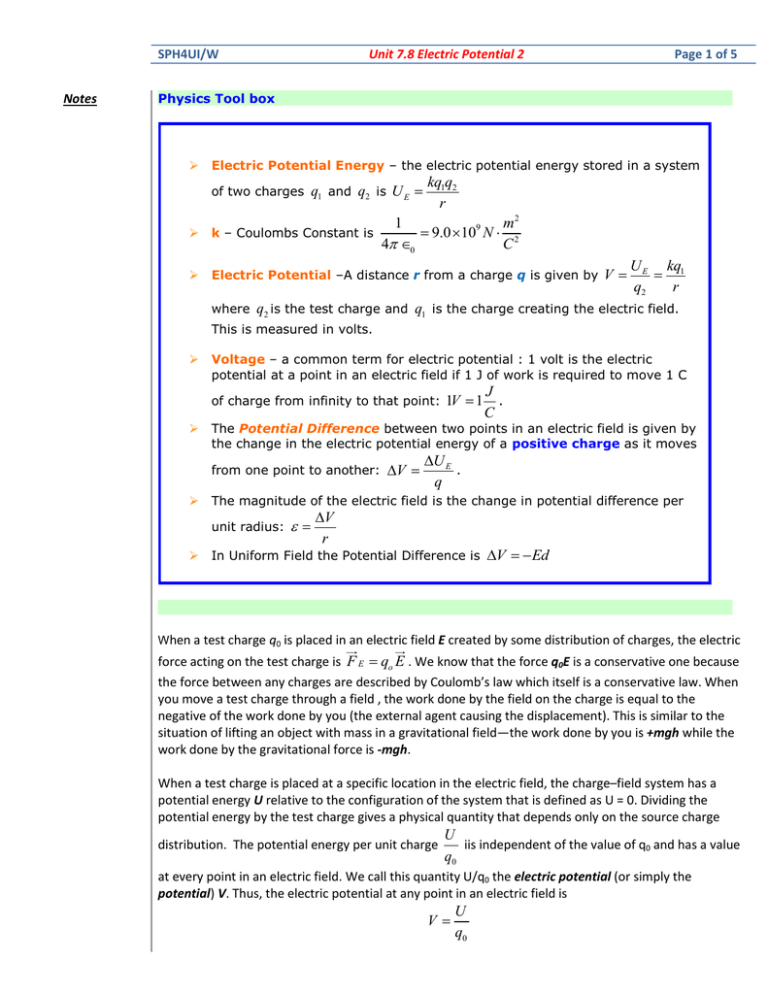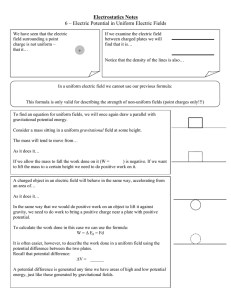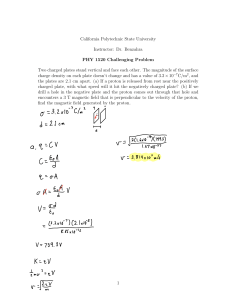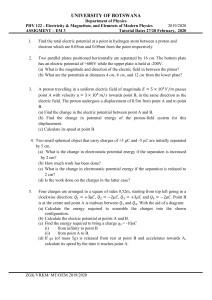Electric Potential 2
advertisement

SPH4UI/W Notes Unit 7.8 Electric Potential 2 Page 1 of 5 Physics Tool box Electric Potential Energy – the electric potential energy stored in a system of two charges q1 and q2 is U E kq1q2 r 1 m2 9.0 109 N 2 4 0 C k – Coulombs Constant is Electric Potential –A distance r from a charge q is given by V where U E kq1 q2 r q2 is the test charge and q1 is the charge creating the electric field. This is measured in volts. Voltage – a common term for electric potential : 1 volt is the electric potential at a point in an electric field if 1 J of work is required to move 1 C of charge from infinity to that point: 1V 1 The Potential Difference between two points in an electric field is given by the change in the electric potential energy of a positive charge as it moves from one point to another: V U E . q The magnitude of the electric field is the change in potential difference per unit radius: J . C V r In Uniform Field the Potential Difference is V Ed W hen a test charge q0 is placed in an electric field E created by some distribution of charges, the electric force acting on the test charge is F E qo E . We know that the force q0E is a conservative one because the force between any charges are described by Coulomb’s law which itself is a conservative law. When you move a test charge through a field , the work done by the field on the charge is equal to the negative of the work done by you (the external agent causing the displacement). This is similar to the situation of lifting an object with mass in a gravitational field—the work done by you is +mgh while the work done by the gravitational force is -mgh. When a test charge is placed at a specific location in the electric field, the charge–field system has a potential energy U relative to the configuration of the system that is defined as U = 0. Dividing the potential energy by the test charge gives a physical quantity that depends only on the source charge distribution. The potential energy per unit charge U iis independent of the value of q0 and has a value q0 at every point in an electric field. We call this quantity U/q0 the electric potential (or simply the potential) V. Thus, the electric potential at any point in an electric field is V U q0 SPH4UI/W Unit 7.8 Electric Potential 2 Page 2 of 5 Notice that since the potential energy is a scalar quantity then that means the electric potential also is a scalar quantity. if our test charge is moved between two positions A and B in an electric field, the charge–field system experiences a change in potential energy. The potential difference V U between two points A q0 and B in an electric field is defined as the change in potential energy of the system when a test charge is moved between the points divided by the test charge q0 Just as we did with potential energy, only the differences in electric potential are meaningful. To avoid having to work with potential differences, however, we often take the value of the electric potential to be zero at some convenient point in an electric field. Potential difference should not be confused with difference in potential energy. The potential difference between A and B depends only on the source charge distribution (consider points A and B without the presence of the test charge), while the difference in potential energy exists only if a test charge is moved between the points. Electric potential is a scalar characteristic of an electric field, independent of any charges that may be placed in the field. Uniform electric Field The formula to let us calculate the potential difference between two points A and B separated by a distance d, in a uniform field is: V Ed The negative sign indicates that the electric potential at point B is lower than at point A; that is, VB VA . Electric field lines always point in the direction of decreasing electric potential, When the electric field E is directed downward, point B is at a lower electric potential than point A. When a positive test charge moves from point A to point B, the charge–field system loses electric potential energy. SPH4UI/W Unit 7.8 Electric Potential 2 Page 3 of 5 Example: A 12-V battery is connected between two parallel plates and produces a specified potential difference V between conductors attached to the battery terminals, as shown below. The separation between the plates is d = 0.50 cm, and we assume the electric field between the plates to be uniform. (This assumption is reasonable if the plate separation is small relative to the plate dimensions and if we do not consider locations near the plate edges.) Determine the magnitude of the electric field between the plates. Solution: The electric field is directed from the positive plate (A) to the negative one (B), and the positive plate is at a higher electric potential than the negative plate is. The potential difference between the plates must equal the potential difference between the battery terminals. E V VB VA 12V V 2400 3 d d 5 10 m m Example: A proton is released from rest in a uniform electric field that has a magnitude of 6.0 104 V The proton undergoes a m displacement of 0.30 m in the direction of E. (a) Find the change in electric potential between points A and B. (b) Find the change in potential energy of the proton–field system for this displacement. SPH4UI/W Unit 7.8 Electric Potential 2 Page 4 of 5 Solution: a) V Ed V 6.0 104 0.3m m 4 1.8 10 V The negative sign means the potential energy of the system decreases as the proton moves in the direction of the electric field. As the proton accelerates in the direction of the field, it gains kinetic energy and at the same time the system loses electric potential energy. b) U q0 V 1.6 1019 C 1.8 104 V 2.9 1015 J SPH4UI/W Unit 7.8 Electric Potential 2 Extra Notes and Comments Page 5 of 5








